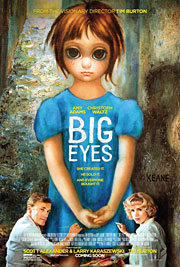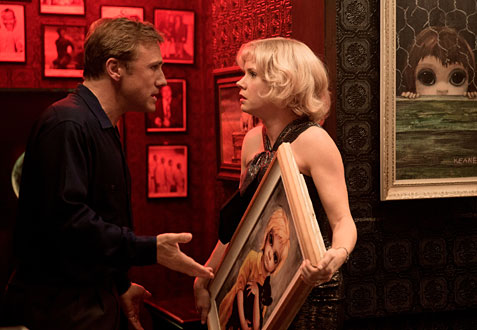
If you were to show somebody a painting of a Campbell’s soup can, chances are that they could identify it as the work of Andy Warhol. But show them a piece from Margaret Keane’s equally popular Big Eyes series, however, and although they’d admit their familiarity with the kitschy paintings, they’d be less likely to name the artist, let alone know the strange-but-true story behind them. That’s the subject of Tim Burton’s latest movie, his first live-action feature to not star Johnny Depp in over a decade. But while it’s a bit of a departure for the oddball director, “Big Eyes” is his best film in years, even if that comes off like a backhanded compliment considering some of the garbage (“Alice in Wonderland,” “Dark Shadows”) he’s released.
The year is 1958, a time when it was still fairly unheard of for a woman to leave her husband, but Margaret Ulbrich (Amy Adams) has done just that, escaping the boredom of suburbia with her daughter Jane (Delaney Raye) for a fresh start in San Francisco. It’s there that she meets smooth-talking artist Walter Keane (Christoph Waltz) at a local art fair, and after hitting it off, the two don’t waste any time getting married. Though Walter hasn’t found much success with his uninspired paintings of Parisian street scenes, he notices something special in Margaret’s wide-eyed waifs and rents some space in a nightclub to show off their artwork. When a couple patrons mistakenly credit Walter with painting one of Margaret’s Big Eyes (after all, they both sign their art “Keane”), he doesn’t bother to correct them in order to close the sale. Margaret gets furious when she finds out that Walter has been passing off her work as his own, but he insists that they’re a team, and before she knows it, the lie has grown so big that she’s unable to stop it in fear that the whole Keane empire, and her life’s work, will be tarnished in the process.
It’s worth mentioning that the story does have a satisfying conclusion, but while Burton allows Margaret to have her day in court, the bulk of the movie is dedicated to the events leading up to it, as Walter slowly reveals himself to be a megalomaniacal prick who favors fame and fortune over integrity. What’s really interesting about the Keanes’ story, however, is that for all the wrong that Walter did, the Big Eyes paintings never would have been such a success without his salesmanship. Margaret might be the talent behind the paintings, but it was Walter who ultimately turned them into a pop culture phenomenon, and he deserves credit for his part in that, no matter how dishonorable his intentions. In fact, it’s pretty ironic how Margaret, who was independent enough to leave her first husband, knowingly trapped herself in a worse situation by agreeing to Walter’s scheme, and Burton stages the domestic drama as an intriguing examination of the perceived male dominance and female submissiveness of the period.
Amy Adams delivers yet another outstanding performance as Margaret Keane, whose façade of female empowerment is stripped away by Walter’s passive-aggressive bullying, leaving behind an emotionally defeated shell of a woman that Adams plays with such honesty that you feel her heartbreak with every betrayal. Christoph Waltz’s bombastic fraud isn’t afforded the same level of complexity, but he still takes what could have been a one-dimensional character and turns him into somewhat of a tragic figure, so desperate for recognition that it’s sad to watch as he becomes consumed by his own lie. While neither role is necessarily Oscar-caliber material, they benefit from being inhabited by a pair of really great actors who always bring their A game.
Unfortunately, “Big Eyes” doesn’t feel like a Tim Burton movie at all, with the director unable to inject his unique visual style apart from a handful of sequences where Margaret imagines the Big Eyes effect on actual people. It makes you wonder what drew such a creative mind to what’s pretty standard biopic material, because although it’s not the first time he’s dabbled in the genre (“Ed Wood”), even that film had a noticeable Burton-esque quality to it. Kudos to the director for taking a break from his usual sci-fi/fantasy leanings in order to make a more straightforward drama, but while “Big Eyes” features some strong lead performances and a fascinating story, just like Margaret Keane’s paintings, it never amounts to more than a pleasant distraction.
Related Posts
Comments Off on Movie Review: “Big Eyes”
Posted in: Entertainment, Movie Reviews, Movies
Tags: Amy Adams, Big Eyes, Big Eyes review, Christoph Waltz, Tim Burton
















